| 1 | The desert highway rattlesnake |
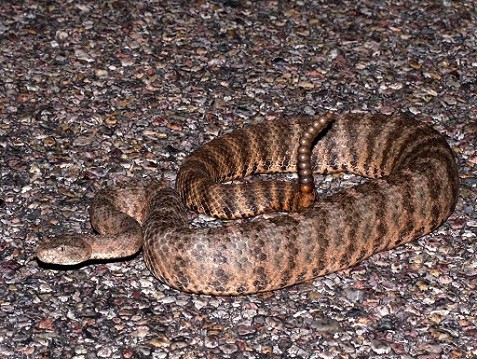
The tiger rattlesnake is a species of the far southern US, occupying two states: most of Arizona and a tiny portion of southeastern New Mexico. Their southern ranges push well beyond the Mexican border, deep into dry Sonora.
Compared to Arizona black rattlesnakes, the tiger rattlesnake likes high temperatures and elevations below 1400 metres. This is a desert snake through and through, as they’re most at home in rolling, parched landscapes dotted with small shrubs and forked cacti. They also venture to rocky canyons and wispy mesquite grasslands, and are most common near rocks. In summer, they tend to hang out in bajadas, gradually inclined land at the foot of desert hills. Another favourite is washes, parched desert streambeds which only flood during monsoon rains. If you ever ran out of fuel on a long desert highway and were forced to proceed on foot, desperately flagging down passing vehicles, the tiger rattlesnake is one you’d be highly likely to bump into.
Despite this, their habitats aren’t quite as extreme as a sidewinder rattlesnake, which even appears in Death Valley. Tiger rattlesnakes are common on the edges of rural settlements in Arizona, often resting in dusty backyards.
| 2 | Unusually neurotoxic |
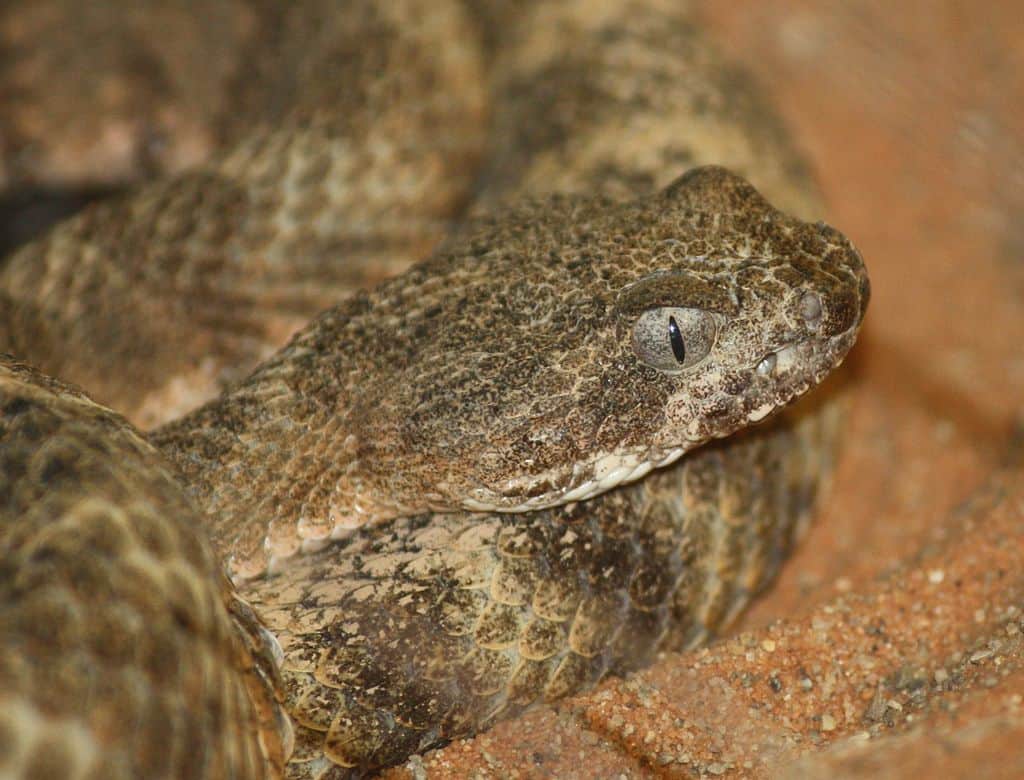
According to lab tests, the tiger rattlesnake has the strongest venom of the entire family. The LD50 toxicity estimate is 0.06mg, just edging out the Mojave rattlesnake at 0.18mg, and well exceeding the western diamondback (which causes the most deaths annually) at 2.2mg.
Its venom is also unusually neurotoxic. Most rattlesnakes possess PLA2s which attack skin cells, effectively predigesting the prey, but tiger rattlesnakes possess the rarer Mojave toxin (also found in Mojave rattlesnakes), which attacks the brain. In mice, this causes random circular movements, clumsy muscle control, followed by flaccid paralysis and death. Before flopping, the mice victims tend to become hyperexcitable for a moment. The venom also causes mild muscle necrosis, and the final cause of death is respiratory failure.
In humans meanwhile, the picture is cloudier. There isn’t a single confirmed death, mainly because they live in cacti-filled deserts. The handful of bites on record were less severe than expected, with few local symptoms or systemic neurotoxicity. This might be because of the tiger rattlesnake’s small fangs (4mm), and its low venom yield of 6-11mg per bite.
| 3 | The simplest rattlesnake venom |
The tiger rattlesnake also has the least complex venom of any rattlesnake, with only a handful of compounds doing the deadly work. The primary ingredients are the neurotoxin Mojavetoxin, and two serine proteases, which comprise 66% and 27% of the venom respectively. The rest include a CRISP-like protein, a disintigrin, and SVMPs, which each comprise 0.1-5% of the fatal mixture.
Tests reveal that tiger rattlesnakes have the ability to make more toxins, but the genes are dormant. 51 genes connected to toxins were found, but only 15 were actively involved in creating peptides and chemicals. This hints that the extra toxins deactivated only recently, perhaps as the overwhelmingly powerful Mojavetoxin made them redundant.
Mojavetoxin only appears in a few other species, such as Mojave and speckled rattlesnakes. Many US rattlesnakes possess the B genetic allele for Mojave toxin, but to actually produce the toxin, you need both the A and B allele, which is rarer (but found in tiger rattlesnakes). Crotalus tigris possesses not just the simplest rattlesnake venom, but the simplest viperid venom worldwide.
| 4 | The smallest rattlesnake head |

The tiger rattlesnake is the holder of many records, another being its tiny head. Its body is nearly three times thicker than the skull at its widest point. This is theorised to be for poking its head into small cracks in rocks and seizing lizard prey with its jaws. The tiny skull contrasts with a well developed rattle, which has 7 segments, versus 2 for the pygmy rattlesnake.
Tiger rattlesnakes have a classic desert colour scheme, with sandy beige contrasting against pale brown, granting it excellent camouflage. This rattlesnake is faded, as though it’s been spun through the washing machine one too many times.
Tiger rattlesnakes were named for their striped patterns, which are less vivid than an actual tiger’s. They coexist in Arizona with the southwestern speckled rattlesnake, which has a similar beige base of colours, but with blotchier patterns and numerous small black dots. Their heads are also larger. Their other Arizona neighbour is the west diamondback rattlesnake, but despite similar colours, these are simpler to distinguish – just look for the diamonds.
| 5 | Neither lazy nor manic |
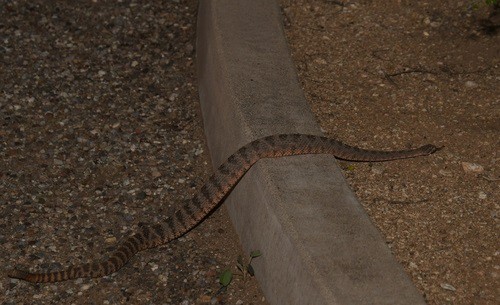
In 1995, a Sonora desert study found that tiger rattlesnakes were significantly less active than their desert-dwelling brethren. Crotalus tigris preferred rocky desert areas in spring and autumn, but moved to the edges of dried out streams (arroyos) in summer.
Their average daily movement was 32.9 metres, which was outstripped by western diamondbacks (50.8m) and black-tailed rattlesnakes (42.9m) living in the same area. But all three are easily outstripped by the sidewinder rattlesnake, which regularly moves 150 metres in a single day, and has the largest home range of any rattlesnake. Tiger rattlesnakes are lazier and have their own cosy desert corner they call home, although they do migrate to find females and new land occasionally.
Male tiger rattlesnakes are more likely to be found in open spaces, including by highways, while females stick to rock shelters. But females emerge from hibernation earlier than males – 18 days earlier on average. Their favourite hibernation spots are rocky slopes in deserts, where they locate cracks and crevices and slither to a point 2-4 feet below ground, before deactivating for the year.
| 6 | Particularly common near Tucson |
If you want to find a tiger rattlesnake personally, then one strategy rules over the rest: road cruising. In a study from Tucson, Arizona, it took an average of 18 person hours to discover a tiger rattlesnake on foot (stomping through the desert), compared to 4 hours while cruising up and down highways.
The study also found that tiger rattlesnakes were the second most common snake in this Tucson locale, with west diamondbacks ranking first. Only 3 gopher snakes and 5 black-tailed rattlesnakes were discovered over the study, compared to 40 tiger rattlesnakes.
Other animals making up this desert neighbourhood included banded geckos, desert spiny lizards, and red-spotted toads. According to the scientists, “The number of tiger rattlesnakes obtained in this study was much higher than we expected“. They concluded that tiger rattlesnakes were surprisingly common in certain local spots.
Tiger rattlesnakes can be extremely loyal to particular hangouts. They can hide in the same woodrat mitten, leafy shrub, or rocky outcrop for year after year.
| 7 | Diet: pocket mice and lizards |
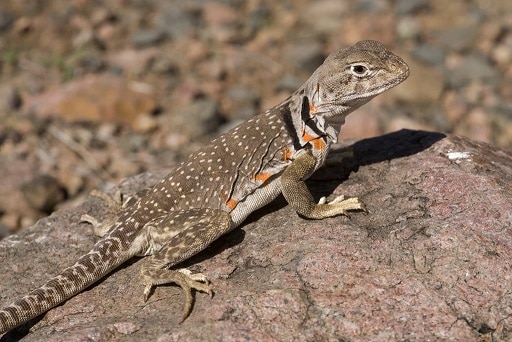
The red diamond rattlesnake leans heavily towards mammals, but tiger rattlesnakes are more flexible eaters. Confirmed prey include common collared lizards, kangaroo rat, woodrats and pocket mice. There’s several conflicting studies: one finding rodents exclusively, one recording mostly small mammals, and another showing a non-fussy diet where they grabbed mammals and reptiles opportunistically.
Their diet varies by location, according to a study from two sites in Tucson, Arizona. At Tanque Verde Ridge, the tiger rattlesnakes ate 3 times more mammals than lizards, while at Rocking K Ranch, the main prey was lizards. After compiling both sites, males were split between reptiles and mammals, while females were more biased towards mammals. However, the mammal-munching tiger rattlesnakes of Tanque Verde Ridge grew significantly faster, both in males and females, from hatchling-dom to adulthood.
Their hunting style is also flexible. Tiger rattlesnakes sometimes wait in ambush near rock piles, but also patrol the desert floor directly and invade mammal burrows.
| 8 | Why rainfall drives them crazy |
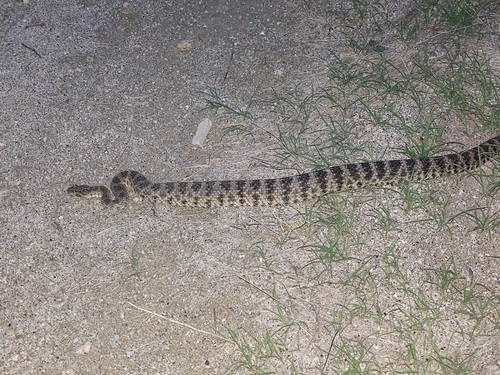
Tiger rattlesnakes are well used to crawling around a bone dry desert. It’s what they expect, but when the heavens open, and truly open rather than just a light sprinkling which fizzles out over the distant mountains, this species shifts to a higher gear.
1998 was a record wet year in Arizona, due to a record-breaking El Nino, an upswell of warm water in the Pacific ocean which affects global weather patterns. A study found that the tiger rattlesnakes near Tucson were unusually active that summer. The males went particularly crazy, seeking out females as though their lives depended on it. More mating was observed in 1998 than any other year, and as expected, 1999 saw a record number of births. Female tiger rattlesnakes usually give birth the year after mating.
It’s possible that rain sends an automatic signal to tiger rattlesnakes, but it’s also theorised that their rodent prey becomes more prolific in rain-soaked years. With deeper calorie reserves, tiger rattlesnakes can expend more on creating the next generation.
| 9 | A solitary rattlesnake species |

Yet another record held by tiger rattlesnakes is that of the smallest litter. Females only pump out newborns every 3 years on average, and this consists of just 2-6 live young (rather than eggs) averaging at 3.4. The western diamondback they coexist with averages at 9 newborns, and black-tailed rattlesnakes average at 7.
Tiger rattlesnakes are relatively solitary, unlike the Arizona black rattlesnake which often gathers in groups of dozens. Tiger rattlesnakes only gather together when males sniff out females. If you expect loyalty from a tiger rattlesnake, then prepare for disappointment: this species has multiple partners over one summer. A study near Tucson found that males and females stuck together for an average of just 3.8 days.
It’s males which track down females in the wide expanses of the desert, using pheromones created by females as they shed their skin. One male was seen following a female for 4 days, while one dumbo was spotted trying to woo a roadkill female.
| 10 | Fate of the tiger rattlesnake |
Tiger rattlesnakes are under threat in local spots, from agricultural conversion, sprawling housing developments, or even glitzy resorts with golf courses. However, they’ve steered clear of the IUCN endangered list, with an official status of “least concern”. There’s believed to be 10,000 lurking in the deserts of Arizona and northern Mexico, mainly moving by night.
Tiger rattlesnakes don’t have an ultra aggressive personality, but they’re far from cowardly. They’re typical for a rattlesnake – they’ll try to avoid detection using camouflage, rattle with their tail if they feel stressed, and strike at the enemy if they fail to heed its warnings.
Tiger rattlesnakes aren’t tiny, but they’re much shorter than their direct neighbours. Their adult length is 50-70cm, with an all-time (confirmed anyway) record of 91.2cm. Meanwhile, the black-tailed rattlesnake has a record length of 152.4cm. The western-diamondback is even larger at a confirmed record of 213cm.
